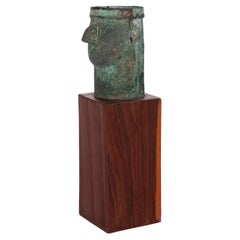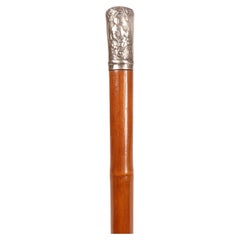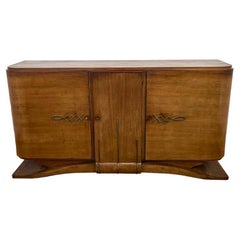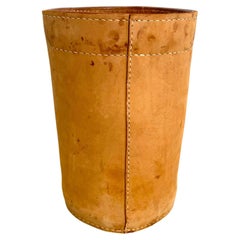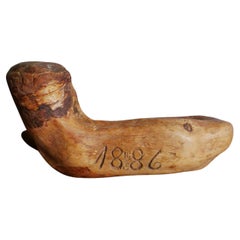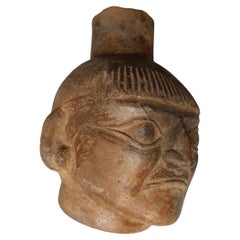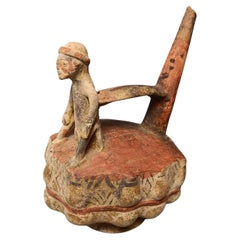Antiquities
22
942
6
to
97
505
364
948
948
948
64
52
44
17
15
13
12
9
5
5
4
4
1
1
1
249
340
353
6
167
123
25
18
19
19
31
23
21
16
8
6
1
416
415
87
75
71
493
184
156
150
87
13
11
4
3
3
Antiquities For Sale
Art Deco Sideboard Made of Rosewood with Brass Applications, Paris, around 1920
Located in Greven, DE
Original Art Deco furniture from a time full of life and elegance. We get all of our furniture unrestored so that we can be sure that it is really original. We then offer these as original until we recondition the furniture in our workshop and then offer it as restored furniture...
Category
1920s French Art Deco Vintage Antiquities
Materials
Brass
Adnet Style Saddle Leather Waste Basket, 1950s France
Located in Los Angeles, CA
Handsome large saddle leather waste bin in the style of Jacques Adnet. Circa 1950s. Extremely thick cowhide with great nubuck finish. Wear as shown. Great patina. Good vintage condit...
Category
1950s French Vintage Antiquities
Materials
Leather
Moleskin top hat, with leather hatbox (late 19th - early 20th century)
Located in Oostende, BE
Moleskin top hat, with leather hatbox (late 19th - early 20th century). The hat was made by Berteil Paris (France), an established house existing since 1840.
Dimensions:
The hat ...
Category
Early 20th Century French Victorian Antiquities
Materials
Fur, Leather
Swedish Birch hook 1886
Located in Farsta, SE
A large pine hook made in 1886 in Sweden is a historical tool used for various purposes. Pine or birch hooks, often made from a sturdy piece of wood, were commonly used in agricultur...
Category
1880s Swedish Scandinavian Modern Antique Antiquities
Materials
Birch
Pre Columbian Moche Portrait Head Vessel South Latin American Antiques
Located in London, GB
A Pre columbian Moche portrait Vessel
A vessel modelled on a Amazonian native American Indian, a personage with a grimacing face perhaps a prisoner the shaved head and fringe is typ...
Category
15th Century and Earlier Peruvian Antique Antiquities
Materials
Pottery
Pre Columbian Lambayeque Stirrup whistle Vessel South Latin American Antiques
Located in London, GB
Pre Columbian Sican Lambayeque Stirrup whistle Vessel
A most interesting stirrup whistle vessel of a man seated on top of a raft of storage vessel, the vessel features a conical sp...
Category
15th Century and Earlier Peruvian Antique Antiquities
Materials
Pottery
Customs officer's walking stick for goods inspection, Germany, 1870.
Located in Milan, IT
System walking stick: Probing stick, used by customs officials to push bales of cotton or other goods, looking for items on which a duty was to be paid. Bamboo wood barrel, silver kn...
Category
Late 19th Century German Antique Antiquities
Materials
Silver, Iron
Silver vermeil handle walking stick with ram’s horn barrel, France 1838.
Located in Milan, IT
A rare walking stick with an octagonal section metal tip and iron tip. Hot-formed ram's horn barrel, with decoration that emulates the hawthorn barrel, silver vermeil handle.
The can...
Category
1830s French Antique Antiquities
Materials
Metal, Silver, Iron
Gadget-system walking stick with bag holder function, Marktroller, Germany, 1920
Located in Milan, IT
Gadget-System cane: cane with bag holder function. Curious stick used to carry shopping bags, made with two upside-down V-shaped fruitwooden shafts, ending with two small iron and ru...
Category
Early 20th Century German Antiquities
Materials
Iron
Chinese Woven River Basket, circa 1900
Located in Chicago, IL
Centuries ago, a woven reed fisherman’s basket such as this would have been common in rural China as an everyday item, used until it became worn through. This hand-woven example rema...
Category
Early 20th Century Chinese Rustic Antiquities
Materials
Willow, Wood
Japanese Bamboo and Paper Fan Leaves Design 1980s
Located in Paris, FR
This is a fan which was made in Japan around 1980s in Showa era.
This is made with a paper and bamboos.
This fan has a lot of stains.
Japanese fans are made of paper on a bamboo ...
Category
1980s Japanese Showa Vintage Antiquities
Materials
Paper
Antique Salt Glazed Clay Apothocary Chemist Hand Painted Jar Tub Pot. c.1900
Located in London, GB
An original salt glazed clay apothecary jar. c.1900
Once containing boric acid and likely used is a pharmacy. Perfect for repurposing as a plant pot or log bin. Remnants of the hand...
Category
Mid-20th Century English Edwardian Antiquities
Materials
Wood
Pre Columbian Mezcala Stone Pendant Axe god Figure Ancient Mexico
Located in London, GB
Pre Columbian Mezcala Stone Pendant Axe god Figure Ancient Mexico
Pre-Columbian, Southern Mexico, Guerrero region, Mezcala culture, ca. 600 to 100 BCE
A abstract serpentine figur...
Category
15th Century and Earlier Mexican Antique Antiquities
Materials
Stone
Japanese Bamboo and Paper Fan Printed 1980s
Located in Paris, FR
This is a fan which was made in Japan around 1980s in Showa era.
This is made with a paper and bamboos. This fan is printed.
Japanese fans are made of paper on a bamboo frame, usual...
Category
1980s Japanese Showa Vintage Antiquities
Materials
Bamboo, Paper
Adnet Style Plaid Waste Basket, 1950s France
Located in Los Angeles, CA
A unique and fun waste bin in a vibrant red and black buffalo check plaid. Made in the style of Jacques Adnet. Presents well and adds great personality to a room. Made of a hardy pla...
Category
1950s French Vintage Antiquities
Materials
Plastic
System walking stick with light, England 1920.
Located in Milan, IT
Gadget-System walking stick: a stick with light. Light in plastic knob at the end of a crook handle. Operated by a pivoting ring on the shaft, the light (which can be either yellow o...
Category
Early 20th Century English Antiquities
Materials
Plastic, Wood
System walking stick with thimble holder function, USA 1900.
Located in Milan, IT
System walking stick, flamed fruit wood barrel, with 925/1000 sterling silver knob and band, acting as a container for a sewing thimble. Brass tip. United States of America early 20t...
Category
Early 20th Century American Antiquities
Materials
Sterling Silver, Brass
Vintage Cast Iron Horse Pony Bank Figure
Located in Asheville, NC
Adorable small vintage cast iron horse bank. Good condition.
Category
Mid-20th Century Antiquities
Materials
Iron
Leather Waste Basket, 1950s France
Located in Los Angeles, CA
Handsome large leather waste bin in a slight conical shape. Circa 1950s. Beautiful tanned leather cowhide with great age and patina. Wear as shown. Good vintage condition.
Located ...
Category
1950s French Vintage Antiquities
Materials
Leather
Japanese Paper Fan Bamboo Hand Painted 1980s Showa
Located in Paris, FR
This is a fan which was made in Japan around 1980s in Showa era.
This fan is made with bamboo and paper. It is hand painted.
Dimensions:
3 x 46 x H27 cm
Japanese fans are made of ...
Category
1980s Japanese Showa Vintage Antiquities
Materials
Bamboo, Paper
A Carved Alpine Oxen Yoke - French Alps - XIXth century.
Located in SOTTEVILLE-LÈS-ROUEN, FR
A huge carved oxen yoke, dating back to the 19th century, is a beautiful example of Alpine folk craftsmanship. Its intricate carvings and rustic charm make it a truly captivating dec...
Category
Late 19th Century French French Provincial Antique Antiquities
Materials
Wood
Antique American Brass Wall-Mount Scales
Located in Pasadena, CA
Great used condition
Category
19th Century American Adirondack Antique Antiquities
Materials
Brass
An antique large padlock & skeleton key - France - Early XXth century.
Located in SOTTEVILLE-LÈS-ROUEN, FR
Antique large padlock accompanied by its original functional skeleton key.
Category
Early 20th Century French Antiquities
Materials
Steel
An antique large padlock & skeleton key - France - Early XXth century.
Located in SOTTEVILLE-LÈS-ROUEN, FR
Antique large padlock accompanied by its original functional skeleton key.
Category
Early 20th Century French Antiquities
Materials
Steel
Antique Hand Painted Sicilian Wedding or Festival Cart Panel
Located in Stamford, CT
Antique carved wood hand painted Sicilian wedding or festival cart panel depicting historical events in Milan Italy. Originally these horse drawn carts were created as a means to tr...
Category
19th Century Italian Antique Antiquities
Materials
Wrought Iron
Folk art walking stick depicting the head of a man, USA 1880.
Located in Milan, IT
Folk art walking stick: one piece of fruitwood depicting the head of a man. United States of America circa 1880.
Category
Late 19th Century American Antique Antiquities
Materials
Fruitwood
System walking stick, fisherman’s seat, France 1900.
Located in Milan, IT
System walking stick: fisherman's seat, very popular for its construction simplicity. The shaft, made of thick bamboo wood, separates into three parts. The fabric part, triangular in...
Category
Early 20th Century French Antiquities
Materials
Fabric, Bamboo
Folk art walking stick depicting thehead of a man with a snake, USA 1880.
Located in Milan, IT
Folk art walking stick: one piece of fruitwood depicting the head of a man with snake along the curved shafts painted green. End of 19th century.
Category
Late 19th Century American Antique Antiquities
Materials
Fruitwood
Vintage Asian Indian Tibetan Silver coral Necklace Ladakh Tribal Jewelry
Located in London, GB
Nice Vintage Asian Indian ethnic Tibetan Silver coral Necklace Ladakh
Typical Ladakh ethnic Himalayan Tibetan Traditional necklace
850 grade silver with coral beads
Conditi...
Category
1980s Indian Vintage Antiquities
Materials
Silver
Goyard Trunk, 1910 France
By Goyard
Located in Los Angeles, CA
Astounding vintage Goyard trunk in a rare extra large size. The oldest and largest antique Goyard trunk available for sale anywhere. Completely original leather, canvas and brass, un...
Category
1910s French Mid-Century Modern Vintage Antiquities
Materials
Brass
Boxwood folk art stick depicting a man with snake and lizard, Italy 1850.
Located in Milan, IT
Folk art stick: single branch of naturally growing boxwood, punctuated by a series of carvings with different subjects, depicting a snake wrapping around the cane and a lizard, the f...
Category
Mid-19th Century Italian Antique Antiquities
Materials
Boxwood
Scandinavian 19th Century Folk Art Wood Grain Shovel
Located in Haddonfield, NJ
This charming folk art shovel is all wood. The patina on this 19th Century piece is incredible and would make a wonderful wall ornament. This shovel would also be impressive added ...
Category
Late 19th Century Scandinavian Folk Art Antique Antiquities
Materials
Wood
Hermes Riding Crop
By Hermès
Located in Los Angeles, CA
Vintage Hermes riding crop with deer antler handle. The shaft is covered in a beautifully braided leather and finished at the bottom with twine. The...
Category
1960s English Vintage Antiquities
Materials
Silver
An Anatolian Marble ‘Star Gazer’ Figure
Located in London, GB
An Anatolian Marble ‘Star Gazer’ Figure
Marble
Anatolian
Early Bronze Age / Circa 2700 - 2100 BC
Size: 5cm high, 3cm wide - 2 ins high, 1¼ ins high
The highly stylised oval head wi...
Category
15th Century and Earlier Turkish Antique Antiquities
Materials
Marble
Antique Boule Ball "7", Pétanque, 1880s, France, Craftsmanship
Located in Greven, DE
Beautiful, unique Boule ball, France, late 19th Century.
In the 19th century, the manufacture of boules balls underwent significant development in France as the game of boules, particularly the pétanque variant, gained in popularity. The manufacture of boules balls during this period was a manual process that required expertise, precision and love to detail.
In the late 19th and early 20th centuries, particularly in rural areas of France and other Mediterranean regions, olive wood was a commonly used source of material for making boules balls. This was not only due to the availability of the material, but also to the outstanding properties of olive wood, which was characterized by hardness, strength and a rich grain.
First, the olive wood was carefully selected and shaped into raw balls, which were then sanded to the desired size and shape. The nails were then hammered into the balls one by one, making sure that they were evenly distributed and firmly anchored. Finally, the spheres were polished and coated with a protective varnish to enhance their natural beauty and protect them from the elements.
The use of nails to decorate and reinforce olive wood boules was a traditional practice that not only gave the ball a rustic aesthetic, but also improved its durability and contributed to customization. Many balls were made according to the specific requirements and preferences of the players. Nails were driven at regular intervals around the ball, with each nail hole precisely placed so as not to affect the balance and weight distribution of the ball. These nails not only served as a decorative element, but also helped to strengthen the structure of the ball and make it more resistant to the hard knocks and wear and tear during play. Individual engravings or decorations were often applied to the balls to make them unique and identify the player.
Antique boules...
Category
Late 19th Century French Late Victorian Antique Antiquities
Materials
Metal
Antique Boule Ball "G", Pétanque, 1880s, France, Craftsmanship
Located in Greven, DE
Beautiful, unique Boule ball, France, late 19th Century.
In the 19th century, the manufacture of boules balls underwent significant development in France as the game of boules, particularly the pétanque variant, gained in popularity. The manufacture of boules balls during this period was a manual process that required expertise, precision and love to detail.
In the late 19th and early 20th centuries, particularly in rural areas of France and other Mediterranean regions, olive wood was a commonly used source of material for making boules balls. This was not only due to the availability of the material, but also to the outstanding properties of olive wood, which was characterized by hardness, strength and a rich grain.
First, the olive wood was carefully selected and shaped into raw balls, which were then sanded to the desired size and shape. The nails were then hammered into the balls one by one, making sure that they were evenly distributed and firmly anchored. Finally, the spheres were polished and coated with a protective varnish to enhance their natural beauty and protect them from the elements.
The use of nails to decorate and reinforce olive wood boules was a traditional practice that not only gave the ball a rustic aesthetic, but also improved its durability and contributed to customization. Many balls were made according to the specific requirements and preferences of the players. Nails were driven at regular intervals around the ball, with each nail hole precisely placed so as not to affect the balance and weight distribution of the ball. These nails not only served as a decorative element, but also helped to strengthen the structure of the ball and make it more resistant to the hard knocks and wear and tear during play. Individual engravings or decorations were often applied to the balls to make them unique and identify the player.
Antique boules...
Category
Late 19th Century French Late Victorian Antique Antiquities
Materials
Metal
Antique Boule Ball "G", Pétanque, 1880s, France, Craftsmanship
Located in Greven, DE
Beautiful, unique Boule ball, France, late 19th Century.
In the 19th century, the manufacture of boules balls underwent significant development in France as the game of boules, particularly the pétanque variant, gained in popularity. The manufacture of boules balls during this period was a manual process that required expertise, precision and love to detail.
In the late 19th and early 20th centuries, particularly in rural areas of France and other Mediterranean regions, olive wood was a commonly used source of material for making boules balls. This was not only due to the availability of the material, but also to the outstanding properties of olive wood, which was characterized by hardness, strength and a rich grain.
First, the olive wood was carefully selected and shaped into raw balls, which were then sanded to the desired size and shape. The nails were then hammered into the balls one by one, making sure that they were evenly distributed and firmly anchored. Finally, the spheres were polished and coated with a protective varnish to enhance their natural beauty and protect them from the elements.
The use of nails to decorate and reinforce olive wood boules was a traditional practice that not only gave the ball a rustic aesthetic, but also improved its durability and contributed to customization. Many balls were made according to the specific requirements and preferences of the players. Nails were driven at regular intervals around the ball, with each nail hole precisely placed so as not to affect the balance and weight distribution of the ball. These nails not only served as a decorative element, but also helped to strengthen the structure of the ball and make it more resistant to the hard knocks and wear and tear during play. Individual engravings or decorations were often applied to the balls to make them unique and identify the player.
Antique boules...
Category
Late 19th Century French Late Victorian Antique Antiquities
Materials
Metal
Victorian Travel Grooming Kit, c. 1900
Located in Chicago, IL
This charming antique box dates to the late 19th century and is a Victorian-era travel kit with sewing and grooming tools, also known as an etui or nécessaire. The compact travel cas...
Category
Late 19th Century American Victorian Antique Antiquities
Materials
Metal
Antique Articulate Artist's Mannequin
Located in Mexico City, CDMX
Circa 1940. We offer this Antique Articulate Artist's Mannequin made in oak wood.
Category
1960s American Industrial Vintage Antiquities
Materials
Wood, Oak
Very Rare and Early Carved Vessel in the Form of a Hedgehog
Located in London, GB
A Very Rare and Early Carved Vessel in the Form of a Hedgehog
Alabaster
Near Eastern
3rd Millenium BC
SIZE: 9.5cm high, 9.5cm wide, 15.5cm deep - 3¾ ins high, 3¾ ins wide, 6 ins ...
Category
15th Century and Earlier Antique Antiquities
Materials
Alabaster
Late-Period to Ptolemaic Period Egyptian Wooden Mummy Mask Ear on Custom Mount
Located in Chicago, IL
This Late Period to Ptolemaic Period Egyptian carved wood ear, once part of a mummy mask, stands as a poignant testament to ancient Egyptian customs and beliefs. Dating back over 250...
Category
15th Century and Earlier Egyptian Egyptian Antique Antiquities
Materials
Wood
Ushabti for Imenmes
Located in London, GB
A mummiform ushabti in blue faience. Four registers of hieroglyphic characters are painted around the lower half of the ushabti, with a vertical column of hieroglyphs in the centre o...
Category
15th Century and Earlier Egyptian Egyptian Antique Antiquities
Materials
Faience
A Finely Carved Gandhara Head of ‘Atlas’
Located in London, GB
A Finely Carved Gandhara Head of ‘Atlas’
Grey schist
India
3rd - 4th Centuries AD
SIZE: 19cm high, 11cm wide, 12.5cm deep - 7½ ins high, 4¼ ins wide, 5 ins deep
References
Pratap...
Category
15th Century and Earlier Indian Antique Antiquities
Materials
Schist
An Openwork Copper Alloy Garment Pin
Located in London, GB
An Openwork Copper Alloy Garment Pin
Superb colour and patina
Bronze
Eastern Iran or Central Asia
2000 BC
SIZE: 35cm wide - 13¾ ins wide
A similar pin in the Louvre-France, was exh...
Category
15th Century and Earlier Persian Antique Antiquities
Materials
Copper
Jacques Adnet Style Saddle Leather Waste Basket, 1950s France
Located in Los Angeles, CA
Handsome large saddle leather waste bin in the style of Jacques Adnet. Circa 1950s. Extremely thick cowhide with great color and age. Wear as shown. Great patina. Good vintage condit...
Category
1950s French Vintage Antiquities
Materials
Leather
Ventaglio firmato nella sua teca 900 - Rose
Located in Lugo, IT
Ventaglio in teca firmato, possibile Spagnolo.
Buone condizioni.
Grazie
Category
1940s European Vintage Antiquities
Materials
Mother-of-Pearl
Adnet Style Saddle Leather Waste Basket, 1950s France
Located in Los Angeles, CA
Handsome large saddle leather waste bin in the style of Jacques Adnet. Circa 1950s. Extremely thick cowhide with great color and age. Wear as shown. Great patina. Good vintage condit...
Category
1950s French Vintage Antiquities
Materials
Leather
Pair Of Antique Boule Balls "3", Pétanque, 1880s, France, Craftsmanship
Located in Greven, DE
Beautiful, unique Boule ball pair and one target ball, France, late 19th Century.
Decorated with the numer "3" on each of the Boule balls.
In the 19th century, the manufacture of b...
Category
Late 19th Century French Late Victorian Antique Antiquities
Materials
Olive
Arma Christi Calvary, France 19th Century
Located in PARIS, FR
Superb and rare Arma Christi calvary, popular work, France end of the 19th century. Beautifully executed work.
Fair condition. Several small misses and ancient restaurations. Seen ...
Category
19th Century French Folk Art Antique Antiquities
Materials
Wood
Antique Boule Set, Boule Balls, Pétanque, 1880s, France, Craftsmanship
Located in Greven, DE
Beautiful, unique Boule set of two Boule balls and one target ball, France, late 19th century.
In the 19th century, the manufacture of boule balls underwent significant development ...
Category
Late 19th Century French Late Victorian Antique Antiquities
Materials
Olive
Pair Of Antique Boule Balls "4", Pétanque, 1880s, France, Craftsmanship
Located in Greven, DE
Beautiful, unique Boule ball pair, France, late 19th Century.
Diameter 9,4 cm.
In the 19th century, the manufacture of boules balls underwent significant development in France as th...
Category
Late 19th Century French Late Victorian Antique Antiquities
Materials
Olive
Pair Of Antique Boule Balls "3", "V", Pétanque, 1880s, France, Craftsmanship
Located in Greven, DE
Beautiful, unique Boule ball pair, France, late 19th Century.
Decorated with the numer "3" on each ball and with a "V" on one of the Boule balls.
In the 19th century, the manufactur...
Category
Late 19th Century French Late Victorian Antique Antiquities
Materials
Olive
Pair Of Antique Boule Balls "G", Pétanque, 1880s, France, Craftsmanship
Located in Greven, DE
Beautiful, unique Boule ball pair, France, late 19th Century.
In the 19th century, the manufacture of boules balls underwent significant development in France as the game of boules,...
Category
Late 19th Century French Late Victorian Antique Antiquities
Materials
Olive
Pair Of Antique Boule Balls, Pétanque, 1880s, France, Craftsmanship
Located in Greven, DE
Beautiful, unique Boule ball pair, France, late 19th Century.
Diameter 9,5 cm.
In the 19th century, the manufacture of boules balls underwent significant development in France as the game of boules, particularly the pétanque variant, gained in popularity. The manufacture of boules balls during this period was a manual process that required expertise, precision and love to detail.
In the late 19th and early 20th centuries, particularly in rural areas of France and other Mediterranean regions, olive wood was a commonly used source of material for making boules balls. This was not only due to the availability of the material, but also to the outstanding properties of olive wood, which was characterized by hardness, strength and a rich grain.
First, the olive wood was carefully selected and shaped into raw balls, which were then sanded to the desired size and shape. The nails were then hammered into the balls one by one, making sure that they were evenly distributed and firmly anchored. Finally, the spheres were polished and coated with a protective varnish to enhance their natural beauty and protect them from the elements.
The use of nails to decorate and reinforce olive wood boules was a traditional practice that not only gave the ball a rustic aesthetic, but also improved its durability and contributed to customization. Many balls were made according to the specific requirements and preferences of the players. Nails were driven at regular intervals around the ball, with each nail hole precisely placed so as not to affect the balance and weight distribution of the ball. These nails not only served as a decorative element, but also helped to strengthen the structure of the ball and make it more resistant to the hard knocks and wear and tear during play. Individual engravings or decorations were often applied to the balls to make them unique and identify the player.
Antique boules...
Category
Late 19th Century French Late Victorian Antique Antiquities
Materials
Olive
Antique Boule Balls Set "B", Pétanque, 1880s, France, Craftsmanship
Located in Greven, DE
Beautiful, unique Boule set of three Boule balls and one target ball, France, late 19th century.
In the 19th century, the manufacture of boules balls underwent significant development in France as the game of boules, particularly the pétanque variant, gained in popularity. The manufacture of boules balls during this period was a manual process that required expertise, precision and love to detail.
In the late 19th and early 20th centuries, particularly in rural areas of France and other Mediterranean regions, olive wood was a commonly used source of material for making boules balls. This was not only due to the availability of the material, but also to the outstanding properties of olive wood, which was characterized by hardness, strength and a rich grain.
First, the olive wood was carefully selected and shaped into raw balls, which were then sanded to the desired size and shape. The nails were then hammered into the balls one by one, making sure that they were evenly distributed and firmly anchored. Finally, the spheres were polished and coated with a protective varnish to enhance their natural beauty and protect them from the elements.
The use of nails to decorate and reinforce olive wood boules was a traditional practice that not only gave the ball a rustic aesthetic, but also improved its durability and contributed to customization. Many balls were made according to the specific requirements and preferences of the players. Nails were driven at regular intervals around the ball, with each nail hole precisely placed so as not to affect the balance and weight distribution of the ball. These nails not only served as a decorative element, but also helped to strengthen the structure of the ball and make it more resistant to the hard knocks and wear and tear during play. Individual engravings or decorations were often applied to the balls to make them unique and identify the player.
Antique boules...
Category
Late 19th Century French Late Victorian Antique Antiquities
Materials
Olive
Antique Boule Set, Boule Balls, Pétanque, 1880s, France, Craftsmanship
Located in Greven, DE
Beautiful, unique Boule set of three Boule balls and one target ball, France, late 19th Century.
Diameter 8,5 cm.
Fantastic colour and patina!
In the 19th century, antique metal boules balls experienced a renaissance that took the game of boules to a new level.
These ornately crafted balls were not only instruments of the game, but also symbols of elegance and sophistication in leisure activities.
Made from high-quality metals such as steel or brass, Boule balls were forged and polished by skilled craftsmen to ensure a smooth and even surface.
The antique boules...
Category
Late 19th Century French Late Victorian Antique Antiquities
Materials
Metal
Antique Boule Ball "G", "J", Pétanque, 1880s, France, Craftsmanship
Located in Greven, DE
Beautiful, unique Boule ball, France, late 19th Century.
Decorated with the initials "G" and "J".
In the 19th century, the manufacture of boules balls underwent significant developm...
Category
Late 19th Century French Late Victorian Antique Antiquities
Materials
Olive
Pair Of Antique Boule Balls, Pétanque, 1880s, France, Craftsmanship
Located in Greven, DE
Beautiful, unique Boule ball pair and one target ball, France, late 19th Century.
In the 19th century, the manufacture of boules balls underwent significant development in France as...
Category
Late 19th Century French Late Victorian Antique Antiquities
Materials
Metal
Recently Viewed
View AllMore Ways To Browse
Pair Of Vintage Display Cabinets
Mid Century Dresser Brass Legs
French Deco Chest
Ormolu Mercury Gold
Antique Painted Black Cabinet
Edwardian English Cabinet
Iron Door Handle
Antique Wood Armoires
Narrow French Cabinet
Lion Chest
Modern Record Storage
Antique English Mahogany Desk
Chinese Cabinet Glass Shelves
Mahogany With Walnut Inlay
Metal Cabinet Drawers Industrial
Shop Chest
Antique Door Sale
Antique Doors Sale

